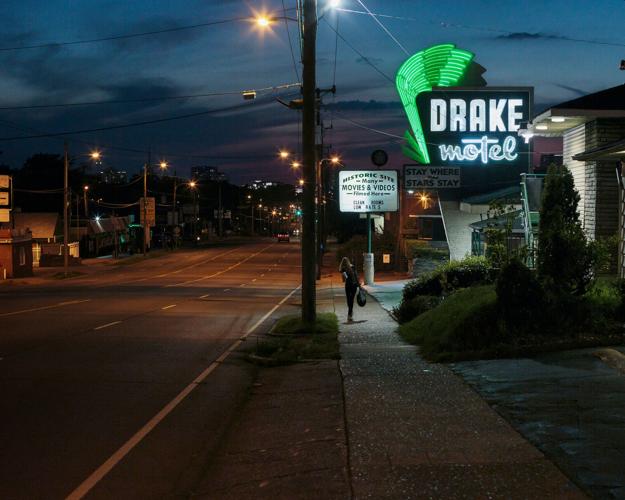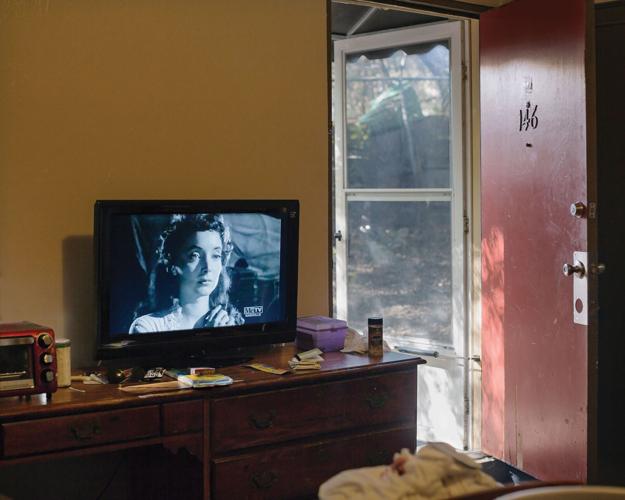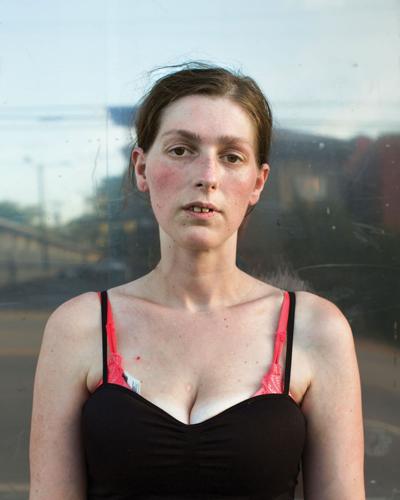
"Untitled," Tamara Reynolds
There’s a crew of five Nashvillians lined up against a wall at Coop Gallery. On opening night, a crowd gathers around them, peering over each other’s shoulders in hopes of catching a glimpse of the figures’ faces up close. Everyone understands that the opportunity to examine, admire and honor these people is both unusual and important. They are five large-scale portraits of some of the unlikely protagonists in one of Nashville’s most stirring examples of documentary photography — Tamara Reynolds’ series The Drake.
The Drake Motel on Murfreesboro Pike opened in the 1950s, and its storied history includes a prominent place in the 1993 River Phoenix film The Thing Called Love. Ashley McBryde shot a music video there for her 2019 song “One Night Standards.” But even though Reynolds named her series after the motel, it’s not her central focus. It’s just effective shorthand for the way things fall apart.
“It’s about a mile from downtown, located in an area that was ignored by developers,” she says in an essay about the series. “Gentrification and homogenization are taking hold of the city I’ve lived in all my life. Somehow, this one little block had escaped notice.”
Reynolds, a lifelong Nashvillian who currently teaches photography at Belmont and Vanderbilt universities, calls the block around the Drake “a microcosm of the disregarded or resentfully tolerated.” She began documenting it in 2015, drawn to the subjects after overhearing a few regulars at the nearby Your Place Cafe speak about sex workers disparagingly. In her essay, Reynolds says this was the moment she knew what story she wanted to tell. “It wasn’t about the overdevelopment of my home city,” she says. “It wasn’t about a forgotten bar or a vintage motel from the bygone years of Nashville. It was about the women walking the block. I wanted to know the women.”

"Untitled," Tamara Reynolds
The five central portraits work like a lineup of day players in a film about Nashville’s underbelly. The first shows a young woman in a faded pink shift dress. She’s standing contrapposto, her socked feet angled slightly inward like those of an insecure teenager. She holds her shoes under one arm and glances warily just out of frame. The photograph is subtly monochromatic — a sun-bleached rust-red wall and dirty brick facade provide a makeshift backdrop, and you can almost imagine her posing for a Barkley Hendricks painting.
At the other end of the group of five, a blond woman with chipped red nail polish gazes up from her cigarette, looking every bit like Cookie Mueller in one of Nan Goldin’s photos from 1980s New York. Like Goldin’s The Ballad of Sexual Dependency, Reynolds’ The Drake is shot with a degree of empathy that demands the viewer identify with the people in the photographs, even when they might initially think they have little in common.
Reynolds’ portraits command the most attention, but she contextualizes them with nuanced photographs of ordinary day-in-the-life vignettes. One such shot is almost like a still life of one of the motel rooms, where a television plays a black-and-white Western from the 1950s — around the same time the motel opened. The TV is focused on the face of a young actress standing in front of a stagecoach. Her expression, when seen in contrast with the disheveled room, appears as concerned disbelief, as if a time traveler from an earlier America were looking out into our contemporary world. The character also works like a stand-in for Reynolds’ intended audience — people gazing in at the lives of those living “just above survival,” as Reynolds has said.
In another photo, a couple holds onto each other in the middle of the street. The man faces away from the camera, but the woman stares right into its lens. In a nearby photo, a man sits in an unpaved patch of sidewalk, his face obscured as a woman looks over him, tending to him in some unseen but evident way. The Drake photos are full of people caring for other people — mostly women caring for men.

"Untitled," Tamara Reynolds
Bringing these figures into a gallery space is not in itself a radical act, but treating them with the tenderness Reynolds does is. Under her gaze, they are all beautiful and deserving of attention. “They gave me what they could give me,” Reynolds says in her essay. “And I took what I could get.”





